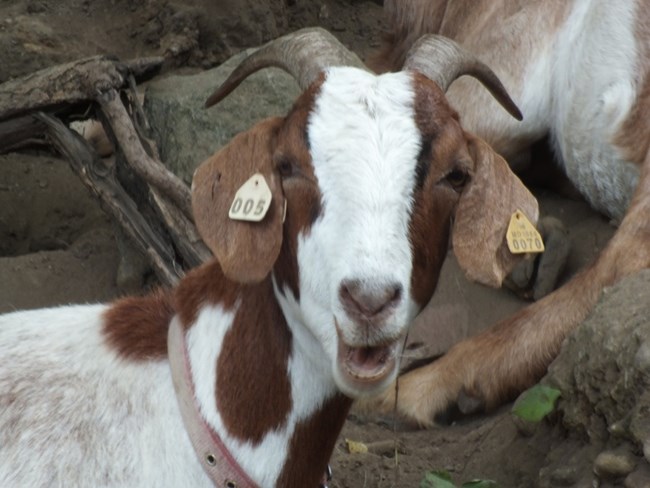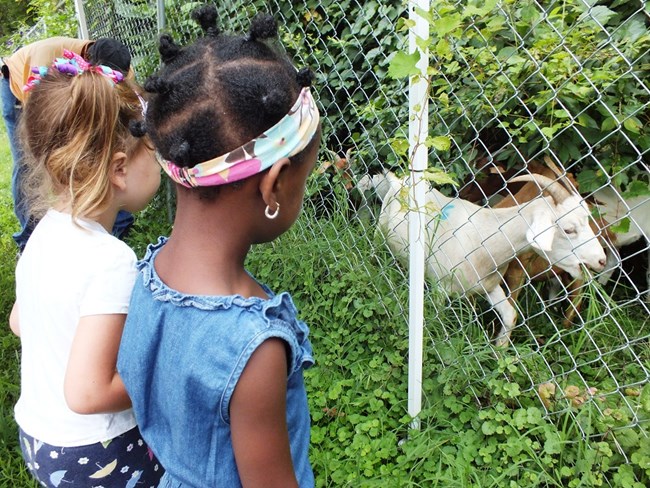Last updated: April 7, 2025
Article
Podcast 056: Goatscaping at Congressional Cemetery

Congressional Cemetery
Invasive Vines
Margaret Puglisi: So Congressional Cemetery was trying to figure out the best solution to some unmaintained land that was just south of our gate. We were having invasive vines choking out the tree growth and the trees were dying and falling on the monuments, so this is a really serious problem when you have a site that has 206 year old gravesites.
Jason Church: So what sort of solution did you guys come up with?
Margaret Puglisi: Well we looked at various factors that we needed to consider. We had environmental impact, we had our societal impact because we have a canine dog walking membership so we have a lot of animals on site and we also needed to make sure that the monuments were considered.
Goats: No Adverse Impact, Lower Costs
Margaret Puglisi: So we chose between mechanical, chemical, human or grazing which would be the goats and we came to the goats because there wasn’t an adverse impact on any of the conditions we were looking at and it also worked out better for costs.
Jason Church: So you looked at mechanical and what sort of adverse effects did that have?
Margaret Puglisi: Well it’s using fuel and also in the case that we had at Congressional, there’s a large ravine and it is such dense overgrowth, there’s large trees, there’s large logs down, it would have been pretty hard for that. Also that wouldn’t have really killed anything because the seeds would still be there. With the goats, their digestive tracts decompose the seeds.
Jason Church: So now you said you also looked at a chemical possibility but you decided against that. So what sort of chemicals did you look at and what was the decision there.
Margaret Puglisi: Well it was mostly herbicides and as we all know that’s really bad for headstones but then we also had the run off to consider and into the Anacostia River because it is so close and we had our dogs to worry about. We’re fond of them and we don’t want anything to happen. So it was cost and it was prohibitive with our considerations that we wanted to adhere to.
Jason Church: So you decided on the grazing option.
Margaret Puglisi: Uh huh.
Jason Church: Historically, had there ever been grazing at Congressional Cemetery?
Margaret Puglisi: We don’t have any record of it.

Congressional Cemetery
Waste Management & Fertilization
Jason Church: What was our time frame? How long were they actually in the cemetery during the day?
Margaret Puglisi: They were there the whole time for eight days. Towards the end of the last day, they, Brian is the name of their guardian, he came and he got half of them and took them to the next project because they were doing so well they were losing finds to eat and he didn’t want them to get bored. So they eat everything from about all the way up to about six feet.
Jason Church: So it took that time period for them to clear the one and a half acres, so if you were for some reason looking at a larger site, would you increase the goat population or do you think you would just have them do their job for longer periods of time?
Margaret Puglisi: I think it was a good number of goats. I think if you just gave them a little bit more time they would be able to accomplish the goal.
Jason Church: Of course one of the immediate questions everyone has about the goats is what about waste management?
Margaret Puglisi: So they were not within our gates so that wasn’t really a problem for us but it’s fertilizer. I’ve actually heard people who say that while the invasive vines are there and the dense growth, wild flowers aren’t able to grow but you know with the fertilization, if there are seeds there, they pop up the next spring so we’re hoping to see that.
Jason Church: Yeah, I guess the lack of competition now and the new fertilizer.
Margaret Puglisi: Right. Yeah.
Jason Church: What was the public’s reaction, the general public’s reaction to the goats?
Margaret Puglisi: I’ve never seen people so excited about goats. We appealed to the public, the neighbors, the social media, we were on Al Jazeera, it must have been a slow week in politics because we had so many different media sources, international and national. We had school groups, it was really educational. People found a lot of different values and benefits from it.

Congressional Cemetery
Cost-Effectiveness: 25 cents per goat
Jason Church: Now I’ve heard from you that it was successful and that you were very happy with the results, what about cost effectiveness? How do you feel that worked into the factor?
Margaret Puglisi: Our president actually did the math and figured out it was about twenty-five cents per goat to be out there. That’s pretty low manual labor rate and they did a great job in a timely fashion so.
Jason Church: Yeah you can’t beat twenty-five cents. Okay. Do you think this something that the cemetery would ever consider for the inside grounds, inside the gates?
Margaret Puglisi: It would have to be, we’d have to put a little more consideration into it. We don’t really have the invasive problem within the cemetery so my concern would be that they would get bored and not be focused on eating and would climb on the headstones and that would not be worth the risk.
Jason Church: Now I know you mentioned briefly before Congressional Cemetery has a very famous dog walking park, you have the K-9 Corps. Tell us a little bit about them?
Margaret Puglisi: They’re actually the reason I would say that we’re so successful because they create an environment that people want to come in, there’s people there, they’re smiling and they started in the nineties. They were tasking themselves to mow the lawn because we were in such a state of abandonment. They were just a really strong presence on our site and…

Congressional Cemetery
Jason Church: …and people pay a subscription to become members…
Margaret Puglisi: Yeah, they pay an annual membership and that goes directly towards our conservation of headstones.
Jason Church: And is the cemetery available 24/7 for the dogs?
Margaret Puglisi: Uh hum, yeah so that also makes a really good security feature with our dog walkers there, they know when something is going on and they’re very happy to tell us if they see some suspicious activity.
Jason Church: Now how did your very well-known dogs get along with your now very well-known goats?
Margaret Puglisi: Towards the beginning the goats were a little bit afraid of the dogs but we had a chain link fence between them and we asked the dog walkers to keep the dogs away because they weren’t familiar with dogs but by the end of the week, I think that the goats were a little bit more intimidating to the dogs after they realized that the dogs couldn’t get to them. They wouldn’t run away from the fence anymore, they would stand and nay and talk to the dogs.
Expanding the Goat Project
Jason Church: Is this a treatment, does the cemetery plan to repeat this in the future and if so how often do you think you might need to repeat it?
Margaret Puglisi: Right. So we have many other places that we could put the goats where there are areas with invasive vines and dying trees so we could do it all around the cemetery really. We’re thinking every two years it will be possible to fund it to bring them in.
Jason Church: Now will there need to be treatments to the invasive species between that period or do you think an every two year cycle will be enough?
Margaret Puglisi: We’ll have to have a crew go in and chop down the actual, they only eat the green foliage so we’d have to have somebody come in and chop down the rest of the bushes to keep them low.
Jason Church: Is this something you would recommend to other sites as well?
Margaret Puglisi: I would as long as you’re able to protect the monuments. If the goal is to save the monuments from dying trees you don’t want to inflict more damage by having goats climbing on them.

Congressional Cemetery
Upcoming Projects
Jason Church: So what projects does Congressional have coming up now?
Margaret Puglisi: Right now we have, we received a $50,000 grant from Partners in Preservation and right now we’re working on the restoration of our mausoleum row of roofs and in that we’re fixing the drainage system, making sure that they’re water tight and also applying a live roof which we are going to put, we have six beehives at the cemetery so we’re going to put them on the live roofs and the circle of feeding the bees and the bees pollinating the flowers should be a good combination.
Jason Church: Now we’re there live roofs there traditionally?
Margaret Puglisi: Grass on them and then I would say probably somewhere in the seventies, eighties, they paved it in concrete which is causing a lot of trouble with the interior and drainage.

Congressional Cemetery
Day of the Dog
Jason Church: Now are you going to remove the concrete that’s currently there put on in the seventies and eighties?
Margaret Puglisi: Yes and we actually have Worcester Eisenbrandt is our contractor. We have an annual “Day of the Dog” where we have vendors set up, we put up an obstacle course, we have a lot of dog adoptions typically and it’s just a day to have the community come in.
Jason Church: When is that?
Margaret Puglisi: That’s August 30th.
Jason Church: And is that open to the public or just the dog walkers…
Margaret Puglisi: Open to the public, yes.
Jason Church: Open to the public, alright.
Margaret Puglisi: It’s a good time to visit us and see if your dog enjoys running around then you might be interested in membership.
Jason Church: Well thank you for talking to us Margaret about all of the animals of Congressional Cemetery. It’s gotten quite the reputation for it’s animals and quite the star goats recently so we look forward to finding out what you guys are doing in the future.
Margaret Puglisi: Thank you.
Read other Preservation Technology Podcast articles or learn more about the National Center for Preservation Technology and Training.
Tags
- ncptt
- preservation technology podcast
- podcasts
- podcast
- congressional cemetery
- cemetery
- congressional cemetery
- environmental impact
- goat
- goatscapingcemetery
- congressional cemetery
- environmental impact
- goat
- goatscaping
- grazing
- invasive vines
- landscaping
- margaret puglisi
- washington dc grazing
- invasive vines
- landscaping
- margaret puglisi
- washington dc
